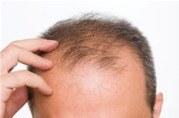Squaric Acid Therapy for Alopecia

Alopecia is the loss of hair. There are two types of alopecia, alopecia areata and androgenic alopecia.
Alopecia areata occurs when the immune system attacks the hair follicles causing hair loss. The hair often falls out in clumps and the extent can vary from a few patches to the entire head (alopecia areata totalis) or entire body (Alopecia areata universalis).
Androgenic alopecia, sometimes called male pattern baldness, occurs when the hair becomes thin and falls out. This occurs mostly in men but can also occur in women (female pattern baldness) due to the increase of androgen hormones.
Causes
The causes for alopecia include ageing, genetics, fungal infections, chemotherapy treatment, low protein and vitamin diet, hormonal changes, excess Vitamin A, stress, certain birth control pills, family history of autoimmune disease, and from hormonal changes during pregnancy and menopause.
Squaric Acid Treatment
Squaric acid dibutyl ester, commonly called squaric acid or SADBE, is a very dilute solution that has been shown to help resolve alopecia in some cases. Squaric acid is a topical sensitizer that provokes an allergic reaction which causes itching, redness, and eventually hair re-growth.
Treatment with squaric acid is widely used for hair loss treatment. A sensitivity patch test is done by applying the SADBE to a small area to determine the concentration that evokes just enough contact dermatitis without causing severe discomfort. Do not wash the sensitivity test area for 24 hours. After sensitization has occurred, usually 1-2 weeks, your doctor will give you home instructions for you to apply squaric acid to the alopecia areas three times a week, preferable at night. Always use gloves and a Q-tip to apply the medication. You will gradually increase the frequency of applying the medication on a weekly basis per your dermatologist's instructions based on your response. If you experience severe itching or discomfort, do not increase the frequency of application and let Dr. Resnik know.
Side-effects can include redness, tiny blisters, pustules and broken skin at the site of application. If this occurs, stop the therapy immediately and call us. You will be prescribed a strong cortisone cream to stop the irritation. Use it twice a day until the irritation disappears, then restart the therapy at the previous interval. Remember that some redness is necessary in order for the medication to help but we do not want broken skin or infection.
It can take several months before you begin to see results and it does not work for everyone. Dr. Resnik can talk to you about other treatment options available if squaric acid treatment is unsuccessful for you.
Schedule your consultation with Dr. Resnik
